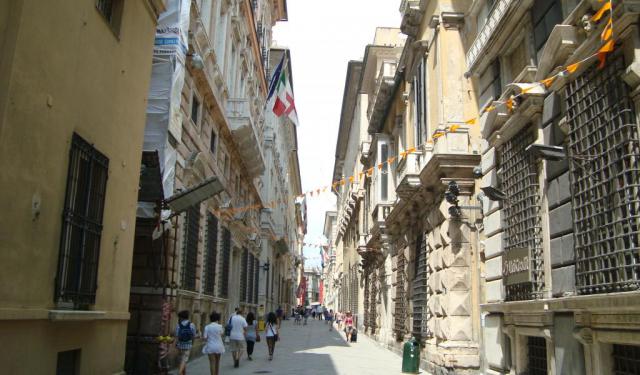Basilica of the Santissima Annunziata del Vastato, Genoa
The word "vastato" derives from the Latin word "vastinium." It means a belt of land outside the walls razed for defensive purposes. The Basilica of the Santissima Annunziata del Vastato was built outside the city walls. Construction began by the Franciscans in 1520 on the previous site of the Church of Santa Maria del Prato.
Work was interrupted in 1537 and not resumed until 1591, when the Lomellini family continued the construction conducted by architect Taddeo Carlone. In the 17th century, Baroque decorations were added under the direction of painter Andrea Ansaldo. The present Neoclassicist facade, designed by Carlo Barabino, was added between 1830 and 1840.
The basilica is fronted with a Latin portico with a triangular roof supported by six ionic stone columns and two pilasters. Above the porch on the facade are two lunette windows, the smaller window above the larger one. Two bell towers flank the building's facade.
The church is laid out in a Latin cross and divided into three naves with two rows of lateral altars. The naves are separated by Corinthian columns with arches. The interior is like a 17th-century gallery of art. It is lavishly decorated with inlaid marble, gilded stucco, and frescoes by 23 local artists and 13 sculptors.
Work was interrupted in 1537 and not resumed until 1591, when the Lomellini family continued the construction conducted by architect Taddeo Carlone. In the 17th century, Baroque decorations were added under the direction of painter Andrea Ansaldo. The present Neoclassicist facade, designed by Carlo Barabino, was added between 1830 and 1840.
The basilica is fronted with a Latin portico with a triangular roof supported by six ionic stone columns and two pilasters. Above the porch on the facade are two lunette windows, the smaller window above the larger one. Two bell towers flank the building's facade.
The church is laid out in a Latin cross and divided into three naves with two rows of lateral altars. The naves are separated by Corinthian columns with arches. The interior is like a 17th-century gallery of art. It is lavishly decorated with inlaid marble, gilded stucco, and frescoes by 23 local artists and 13 sculptors.
Want to visit this sight? Check out these Self-Guided Walking Tours in Genoa. Alternatively, you can download the mobile app "GPSmyCity: Walks in 1K+ Cities" from Apple App Store or Google Play Store. The app turns your mobile device to a personal tour guide and it works offline, so no data plan is needed when traveling abroad.
Basilica of the Santissima Annunziata del Vastato on Map
Sight Name: Basilica of the Santissima Annunziata del Vastato
Sight Location: Genoa, Italy (See walking tours in Genoa)
Sight Type: Religious
Guide(s) Containing This Sight:
Sight Location: Genoa, Italy (See walking tours in Genoa)
Sight Type: Religious
Guide(s) Containing This Sight:
Walking Tours in Genoa, Italy
Create Your Own Walk in Genoa
Creating your own self-guided walk in Genoa is easy and fun. Choose the city attractions that you want to see and a walk route map will be created just for you. You can even set your hotel as the start point of the walk.
Genoa Introduction Walking Tour
Petrarch, an Italian poet of the early Renaissance known as the "father of humanism," called Genoa "La Superba" (The Proud One). Genoa is deservedly proud of her maritime glory and unique architecture.
From the 11th century until the late 18th century, the city became a leading economic and military power in Europe. It was one of the wealthiest cities in the world through... view more
Tour Duration: 2 Hour(s)
Travel Distance: 3.8 Km or 2.4 Miles
From the 11th century until the late 18th century, the city became a leading economic and military power in Europe. It was one of the wealthiest cities in the world through... view more
Tour Duration: 2 Hour(s)
Travel Distance: 3.8 Km or 2.4 Miles
Rolli Palaces Walking Tour
The Rolli di Genova – or, more precisely, the Rolli degli alloggiamenti pubblici di Genova (Italian for "Lists of the public lodgings of Genoa") – were first established in the Republic of Genoa in 1576. Originally, these official lists included private palaces and mansions belonging to the most distinguished local families, which - if chosen through a public lottery - were obliged... view more
Tour Duration: 1 Hour(s)
Travel Distance: 0.4 Km or 0.2 Miles
Tour Duration: 1 Hour(s)
Travel Distance: 0.4 Km or 0.2 Miles





